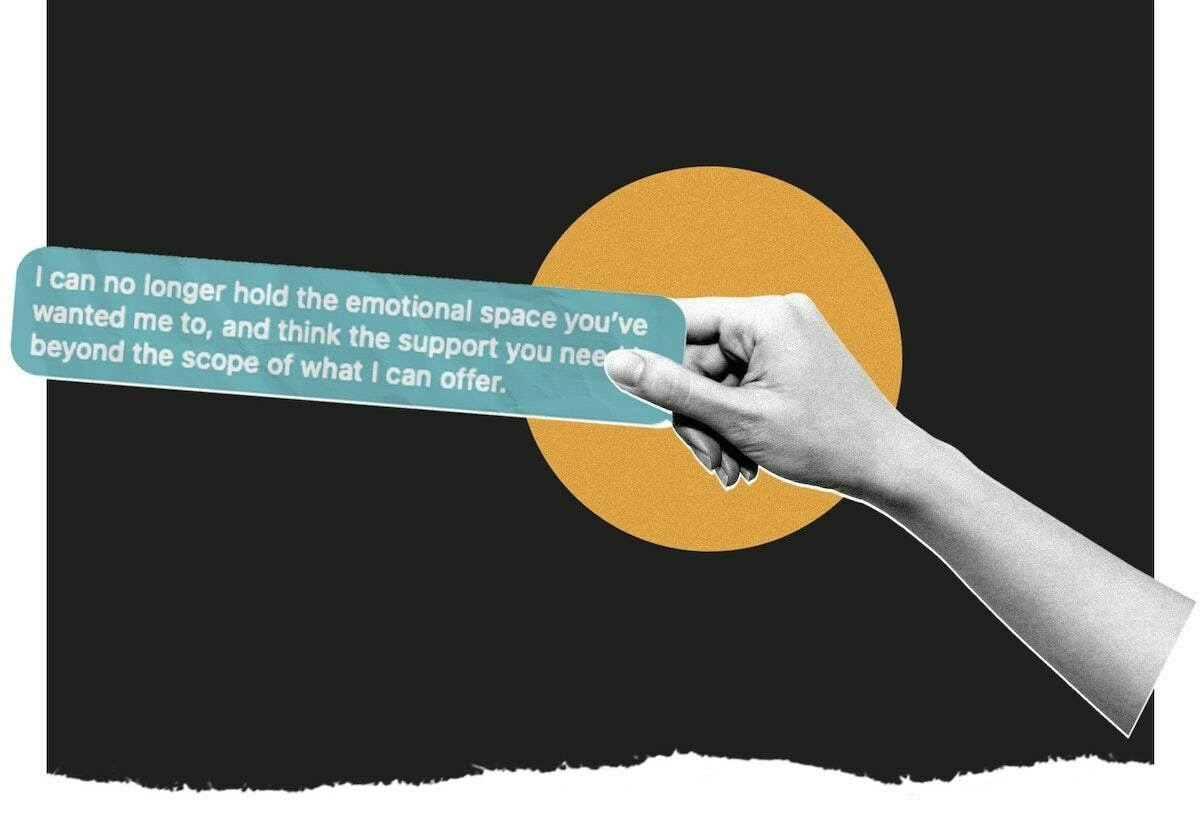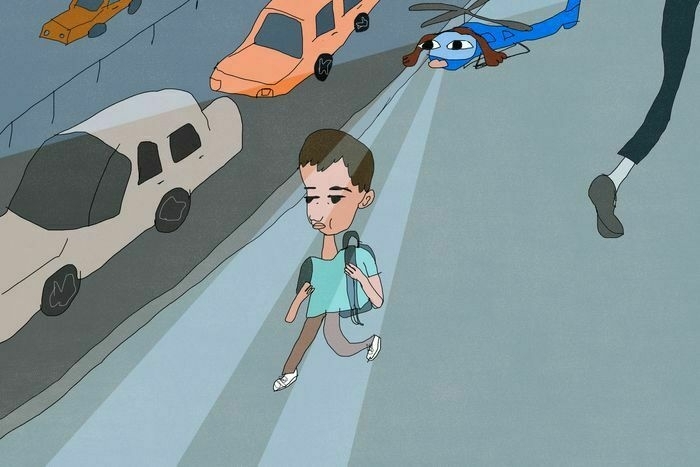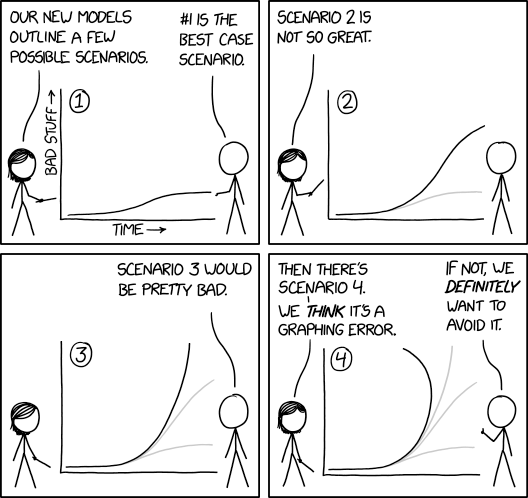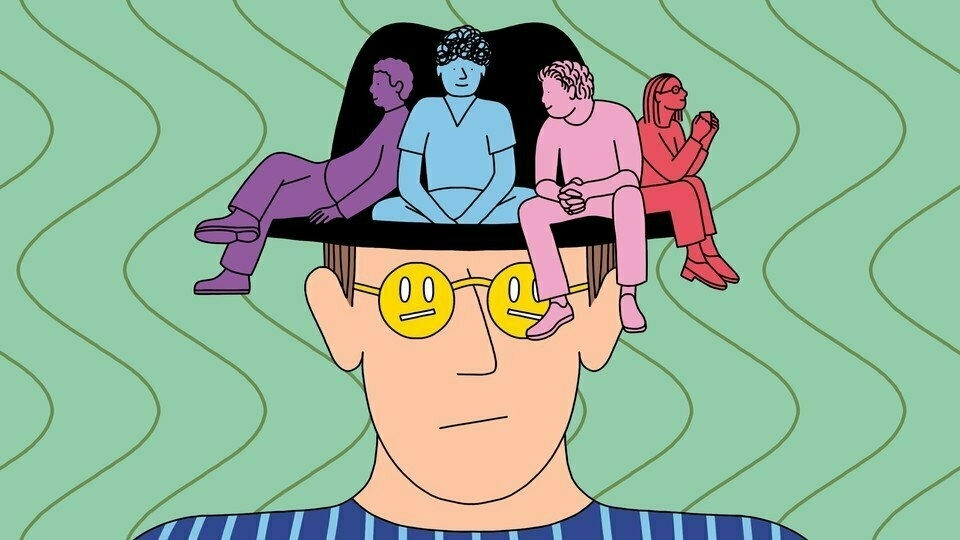2023
-
Why are we here? [PURPOSE]
-
How are we different? [POSITIONING]
-
Why should you care? [PROPOSITION]
The problem with feminism is not that it has gone too far. It is that it has not gone far enough.
I listened to a podcast episode earlier this week entitled What the World of Psychology Gets Wrong About Men. After a few minutes, I considered turning it off, as I felt that the guest, Dr. John Barry, was about to stray into “men are under attack” territory.
But I kept listening, and I was wrong. It was a really balanced, well-structured conversation which pointed out how problematic the term “toxic masculinity” is when it’s applied to any behaviour we don’t like that’s exhibited by men. That’s not how the phrase originated.
This article is a review of Richard Reeves' new book. What struck me about it was the discussion of how young men’s veneration of hugely problematic figures such as Jordan Peterson, Andrew Tate, and Donald Trump is a symptom of male alienation. “Women’s lives have been recast. Men’s lives have not.”
In his new book, 'Of Boys and Men', Richard Reeves argues that the [crisis of masculinity] is structural. Society has undergone profound cultural and economic changes in the past few decades and many of them have left men—especially working-class men—disoriented and demoralized. As certain structural barriers that used to hinder women have been removed, women have proven their “natural advantage” in several areas, including in our colleges and universities. The structural disadvantages faced by men, meanwhile, have only become more entrenched during the same period. Several rounds of globalization, more outsourcing of traditionally “male” sectors like heavy industry, increasing automation, and greater workplace competition from women meant that, for many men, the economic picture has been getting bleaker by the year.Source: Have Men Become Culturally Redundant? | Commonweal MagazineAs a result, many men are struggling to fulfill their own outmoded expectations of what a man should be. “The problem with feminism, as a liberation movement, is not that it has ‘gone too far,’” Reeves writes. “It is that it has not gone far enough”—that is, it has not succeeded in replacing traditional models of masculinity with something more adequate to our current circumstances. The Western male is stuck in a culture of masculinity that is now desperately mismatched with his material reality. “Women’s lives have been recast,” Reeves writes. “Men’s lives have not.” Men have been consigned to “cultural redundancy.”
[…]
Addressing the kind of male disadvantages that Reeves catalogs does not mean ignoring or excusing inequalities that favor men over women. It’s possible, Reeves writes, to “hold two thoughts in our head at once.” Indeed, it’s urgent that we do so.
The future of AI will always be more than six months away
A remarkably sober look at the need for regulation, transparency around how models are trained, and costs in the world of AI. It makes a really good point about the UX required for machine learning to be useful at scale.
“I have learned from experience that leaving tools completely open-ended tends to confuse users more than assist,” says Kirk. “Think of it like a hall of doors that is infinite. Most humans would stand there perplexed with what to do. We have a lot of work to do to determine the optimal doors to present to users.” Mason has a similar observation, adding that “in the same way that ChatGPT was mainly a UX improvement over GPT-3, I think that we’re just at the beginning of inventing the UI metaphors we’ll need to effectively use AI models in products.”Source: AI Can’t Take Over Everyone’s Jobs Soon (If Ever) | IEEE Spectrum[…]
Augmenting work with AI could be worthwhile despite these problems. This was certainly true of the computing revolution: Many people need training to use Word and Excel, but few would propose typewriters or graph paper as a better alternative. Still, it’s clear that a future in which “we automate away all the jobs, including the fulfilling ones,” is more than six months away, as the Future of Life Institute’s letter frets. The AI revolution is unfolding right now—and will still be unfolding a decade from today.
An urgency to somehow bend the algorithms
The album ‘Homework’ by Daft Punk came out in 1997 when I was 16 years old. That’s the same age as my son is now. I think it’s fair to say that it changed my life.
When I worked in HMV as a student, I used my access to the huge database to discover and order in rare Japan-only releases of Daft Punk’s music. I also discovered music that the duo behind Daft Punk, Thomas Bangalter and Guy-Manuel de Homem-Christo, released on their own labels.
I was sad when I learned that Daft Punk was to be no more, but reading this interview with Thomas Bangalter in The Guardian helps make sense. I think it’s particularly important in life not to become a caricature of yourself. For Bangalter going from scoring a film like Irréversible to ballet couldn’t be more different, really.

Did the future lose its allure at some point? “It’s interesting,” he ponders. “You either have the content or the form. Every artist wants to create their own little revolution and try to do things that haven’t been done. That’s kind of the punk aspect. But you ultimately become a caricature of yourself once you succeed.” The point, he says, is to do something different every time. “It works in opposition. These robots, they’re like the glorification of technology. But even in 2005, when we made this film Electroma, they wanted to become human. It’s human nature – the grass is always greener on the other side.”Source: Up all night to get jeté! Thomas Bangalter on hanging up his Daft Punk helmet – and leaping into ballet | The Guardian[…]
Where does Bangalter feel Daft Punk’s influence now? “There used to be a lot of barriers between genres of music. I was hopeful there was a possibility to break these. That was part of the message of what we did musically.” Pop tribalism is indeed over, and while that can’t be credited to Daft Punk alone – piracy, streaming and three decades of internet did their bit – his hunch was once again correct.
“In some way the world is much more polarised now, but not really musically – musically there is this ability to mix and match and create levels of conflicting aesthetics or clashing ideas. I just hope that the tolerance existing right now in music will exist more in society as well.” The defecting robot has one more warning: “Now there is an urgency to somehow bend the algorithms.”
The web is fragmentary
I love that this article channels both Tracey Ullman’s excellent book Close to the Machine and the weird allure of spreadsheets. I have a love/hate relationship with the latter, I have to say.
The key point that this article makes, which I think a few of us realised even before the pandemic, is that the web is fragmentary by default. Huge silos of common experience will come and go, and that’s OK.
Source: There’s No Such Thing as a One-Size-Fits-All Web | WIREDIf we were to wipe the slate clean—no more platform-specific formats, no more slick UIs, no more engagement-capturing algorithms—would web users even know what to make online? The question has felt particularly acute these past few months, as Twitter users flounder to figure out where to go next, even as they still feel tethered to the increasingly broken platform. Setting aside the very real issue of building a critical mass of users on another site, the question of what to do on another site runs through many of these conversations. In an ideal world, what would a platform allow a user to do?
[...]Creation on the web has always been about those constraints, whether technical limitations or the specific ways systems were designed. By the late ’90s, the web had grown much more participatory than the one Ellen Ullman was writing about. With a little HTML and CSS, ordinary users could create all sorts of things on the proverbial blank page—so long it was mostly text, with maybe a few low-res images or the occasional sparkly animated gif. The first decade of the 2000s saw the rise of both social networking and blogging, but even as technical capabilities were rapidly expanding, for the average user it was far less of a free-for-all than the DIY spirit of the early years. The Web 2.0 shift to user-generated content centered the user—but it was on the platforms’ terms. And in an effort to make content creation as “user-friendly” as possible, platforms were once again, after the openness of the webring/Geocities era, building narrow pathways for users to take.
[…]
But constraints on the web today aren’t just about what our tools encourage us to do on a technical level—they’re also about what it’s like, more broadly, to use a platform. “On the old-school internet that I was on when I was a teenager, the constraints were the tools,” says [Michael Ann DeVito, a postdoctoral computing innovation fellow in the Department of Information Science at the University of Colorado Boulder]. “Could you create a hit viral video in 1996? No, we did not have the technology and infrastructure to get that video distributed. For a one-minute video, you would spend two days uploading it, and nobody would have had the connection to download it. The systems didn’t afford that kind of expression.”
[…]
The ideal solution likely lies in multiplicity: no massively scaled platform can do everything, so why continue trying to make one size only sort of fit all? Fragmenting our social and creative platforms wouldn’t just expand the ways we could share things with the world; a greater variety of affordances—and yes, constraints as well—would give us a greater range of pathways into creativity. As the current big platforms rush to copy each other (or, more to the point, copy TikTok), the idea of smaller, more varied platforms might feel antithetical; so, too, might the idea that the tech industry would be willing to invest in something that won’t endlessly grow. But the current platform malaise won’t be solved by scale and brute force. Users have many different needs, and in the next era of the web, they should be offered many different solutions.
The patchwork progress of maturity
This short post outlines in a pithy way how being an adult is so difficult: we mature in different aspects of our lives at different rates. In turn, this makes relationships difficult — especially as a parent.

We tend to think of immaturity and maturity as dichotomous, uniform states. Once you leave behind the former and enter the latter, you’re mature through and through.
Yet, in reality, maturation follows a patchwork pattern of progress.
[...]
Maybe you react to receiving criticism with stoic equilibrium, but respond to having your birthday forgotten with perturbed petulance.
Maybe you can give a presentation at work with perfect confidence, but can’t approach an attractive woman without sweat-inducing fear.
[...]
As the midcentury writers Harry and Bonaro Overstreet put it, “All through life we have to take turns, as it were, being ‘parents’ to one another — because we all take turns at being children.”
Source: Sunday Firesides: Parent the Immature in Others | The Art of Manliness
Image: Midjourney (prompt in alt text)
Fitting LLMs to the phenomena
The author of this post really needs to read Thomas Kuhn’s The Theory of Scientific Revolutions and some Marshall McLuhan (especially on tetrads).
What he’s describing here is to do with mindsets, the attempt we make to try and fit ‘the phenomena’ into our existing mental models. When that doesn’t work, there’s a crisis, and we have to come up with new paradigms.
But, more than that, to use McLuhan’s phrase, we “march backwards into the future” always looking to the past to make sense of the present — and future.
I have a theory that technological cycles are like the stages of Squid Game: Each one is almost entirely disconnected from the last, and you never know what the next game is going to be until you’re in the arena.Source: The new philosophers | Benn StancilFor example, some new technology, like the automobile, the internet, or mobile computing, gets introduced. We first try to fit it into the world as it currently exists: The car is a mechanical horse; the mobile internet is the desktop internet on a smaller screen. But we very quickly figure out that this new technology enables some completely new way of living. The geography of lives can be completely different; we can design an internet that is exclusively built for our phones. Before the technology arrived, we wanted improvements on what we had, like the proverbial faster horse. After, we invent things that were unimaginable before—how would you explain everything about TikTok to someone from the eighties? Each new breakthrough is a discontinuity, and teleports us to a new world—and, for companies, into a new competitive game—that would’ve been nearly impossible to anticipate from our current world.
Artificial intelligence, it seems, will be the next discontinuity. That means it won’t tack itself onto our lives as they are today, and tweak them around the edges; it will yank us towards something that is entirely different and unfamiliar.
AI will have the same effect on the data ecosystem. We’ll initially try to insert LLMs into the game we’re currently playing, by using them to help us write SQL, create documentation, find old dashboards, or summarize queries.
But these changes will be short-lived. Over time, we’ll find novel things to do with AI, just as we did with the cloud and cloud data warehouses. Our data models won’t be augmented by LLMs; they’ll be built for LLMs. We won’t glue natural language inputs on top of our existing interfaces; natural language will become the default way we interact with computers. If a bot can write data documentation on demand for us, what’s the point of writing it down at all? And we’re finally going to deliver on the promise of self-serve BI in ways that are profoundly different than what we’ve tried in the past.
Žižek on ChatGPT
Slavoj Žižek is never the easiest academic to read, and this (translated) article about ChatGPT and AI is no different. However, if you skip the bizarre introduction, I do think he makes an interesting point about people being able to blame AI’s for ambiguity and misunderstandings.
Just as we create an online avatar through which to engage the Other and affiliate with online fraternities, might we not similarly use AI personas to take over these risky functions when we grow tired, in the same way bots are used to cheat in competitive online video games, or a a driverless car might navigate the critical journey to our destination? ... We just sit back and cheer on our digital AI persona until it says something completely unacceptable. At that point, we chip in and say, ‘That wasn’t me! It was my AI.’Source: ChatGPT Says What Our Unconscious Radically Represses | Sublation MagazineTherefore, the AI “offers no solution to segregation and the fundamental isolation and antagonism we still suffer from, since without responsibility, there can be no post-givenness.” Rousselle introduced the term “post-givenness” to denote “field of ambiguity and linguistic uncertainty that allows a reaching out to the other in the field of what is known as the non-rapport. It thus deals directly with the question of impossibility as we relate to the other. It is about dealing with our neighbour’s opaque monstrosity that can never be effaced even as we reach out to them on the best terms.”
[…]
“We dream outside of ourselves today, and hence that systems like ChatGPT and the Metaverse operate by offering themselves the very space we have lost due to the old castrative models falling by the wayside.” With the digitized unconscious we get a direct in(ter)vention of the unconscious - but then why are we not overwhelmed by the unbearable closeness of jouissance (enjoyment), as is the case with psychotics?
Relationships and therapy-speak
I’m hugely supportive of people choosing therapies such as CBT and using language from NVC. However, it’s possible to go too far.
My wife has told me “not to use that language” with her before when she thinks that I’m using it in a way that doesn’t feel in some way natural. And it seems that it’s particularly prevalent in younger generations? Interesting article.
In recent years, therapy concepts like self-care and boundary-setting have shown up everywhere online, with Instagram accounts and other social media communities sharing mantras and advice advocating for self-actualization. TikTok therapists like Nadia Addesi and TherapyJeff offer tips for struggling with anxiety, self-esteem, and people-pleasing. “Therapy speak” — prescriptive language describing certain psychological concepts and behaviors — can be found everywhere from group chats to dating apps. Now, we have more language to advocate for ourselves and our needs, whether it be canceling plans when we feel overwhelmed or ending relationships that no longer serve us.Source: Is Therapy-Speak Making Us Selfish?It’s important to be able to set boundaries and advocate for yourself. Occasionally, though, the emphasis on protecting one’s individual needs can overlook the fact that someone else is on other side of that boundary-setting. In 2019, for instance, a relationship coach’s Twitter thread offering a template for telling friends in need of support that you’re “at capacity” at the moment drew criticism for equating friendship to emotional labor. Earlier this year, a clinical psychologist’s TikTok video outlining how to break up with a friend went viral after viewers pointed out that it sounded like a missive from HR. Critics have noted that personal relationships require a touch more compassion than some of these therapeutic blueprints offer.
[…]
There are reasons a person might be tempted to overindulge in some of this self-care behavior. Conflict can be difficult, and people might think they can avoid it by asserting their needs in a way that prevents the other person from responding — by using HR language to end a friendship, for instance, or via straight-up ghosting. And by couching the behavior in therapy language, the hard “boundary” can feel more legitimate, or even virtuous.
[…]
Beyond boundary-setting and inflexibility, the proliferation of therapy speak has also inspired some people to assign labels like “toxic” and “narcissistic” to certain relationships or behaviors. Though toxic people and narcissists do exist, these armchair diagnoses don’t always accurately capture every dynamic, and being on the receiving end of this language can be destabilizing when it’s misplaced.
More on why billionaires should not exist
This article frames ultra-rich people owning and using superyachts and private jets as ‘theft’ because it reduces the amount of time we’ve got to avert climate disaster.
Yes, it is.
But it’s also theft because the purchase of these yachts and jets are only possible because of the enormous sums of money stolen from workers to fund their extravagant lifestyles.
Owning or operating a superyacht is probably the most harmful thing an individual can do to the climate. If we’re serious about avoiding climate chaos, we need to tax, or at the very least shame, these resource-hoarding behemoths out of existence. In fact, taking on the carbon aristocracy, and their most emissions-intensive modes of travel and leisure, may be the best chance we have to improve our collective climate morale and increase our appetite for personal sacrifice, from individual behavior changes to sweeping policy mandates.Source: The Superyachts of Billionaires Are Starting to Look a Lot Like Theft | The New York TimesOn an individual basis, the superrich pollute far more than the rest of us, and travel is one of the biggest parts of that footprint. Take, for instance, Rising Sun, the 454-foot, 82-room megaship owned by the DreamWorks co-founder David Geffen. According to a 2021 analysis in the journal Sustainability, the diesel fuel powering Mr. Geffen’s boating habit spews an estimated 16,320 tons of carbon-dioxide-equivalent gases into the atmosphere annually, almost 800 times what the average American generates in a year.
And that’s just a single ship. Worldwide, more than 5,500 private vessels clock in about 100 feet or longer, the size at which a yacht becomes a superyacht. This fleet pollutes as much as entire nations: The 300 biggest boats alone emit 315,000 tons of carbon dioxide each year, based on their likely usage — about as much as Burundi’s more than 10 million inhabitants. Indeed, a 200-foot vessel burns 132 gallons of diesel fuel an hour standing still and can guzzle 2,200 gallons just to travel 100 nautical miles.
Negative UK growth
Growth isn't everything. However, the fact that the word 'Brexit' does not appear anywhere in this article tells you all you need to know about (a) British politics, and (b) the relationship between the government and the BBC.
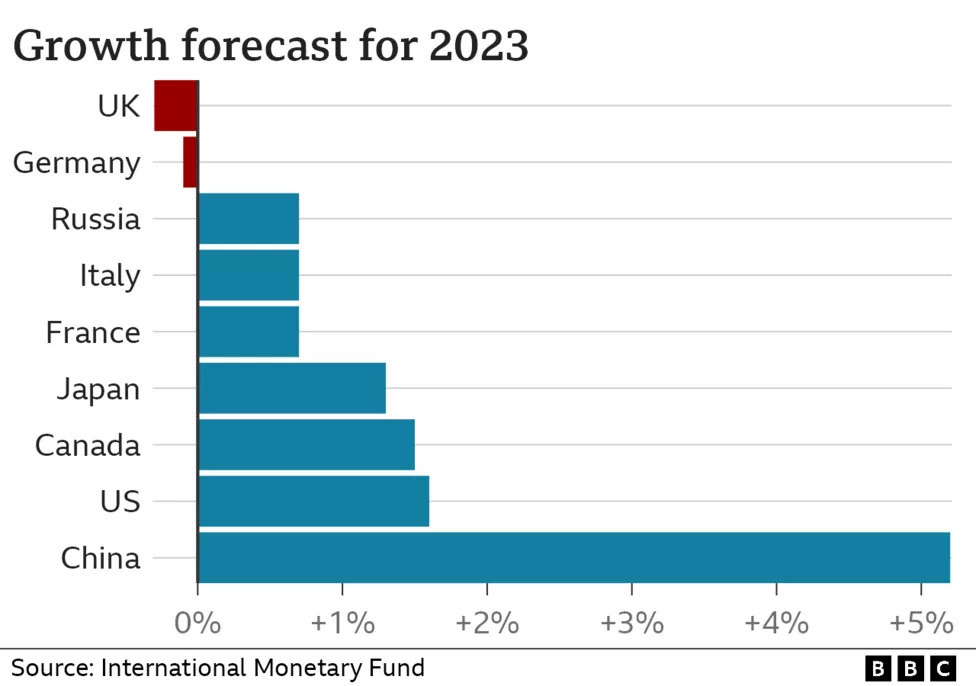
The UK is set to be one of the worst performing major economies in the world this year, according to the International Monetary Fund (IMF).
[...]
IMF researchers have previously pointed to Britain's exposure to high gas prices, rising interest rates and a sluggish trade performance as reasons for its weak economic performance.
[...]
Liberal Democrat Treasury spokesperson Sarah Olney said the forecast was "another damning indictment of this Conservative government's record on the economy".
Source: UK to be one of worst performing economies this year, predicts IMF | BBC News
The laziness of helicopter parenting
This article in The Cut by Kathryn Jezer-Morton is fantastic. There’s a tension in parenting between, on the one hand, giving your kids space to grow, be themselves, and make mistakes — and, on the other, looking out for them, being time-efficient, and avoiding the opprobrium of other parents.
As my kids get older, I am learning how labor-intensive it is to teach them to be independent, and I’m beginning to think that we have the helicopter-parent/hands-off-parent binary all wrong. Maybe helicopter parenting is a form of neglect, one that might even be comparable in its harmfulness to the kind of neglect that forces kids to grow up by their own wits. The crisis of teen mental health in the wake of COVID can be explained in all sorts of ways, but a common denominator is that many teenagers feel that they have no control over their lives, which is distressing for any human. When you teach a kid to be safely independent, you give them some of that control. Denying a kid that opportunity is cruelty disguised as parental virtue – it’s beyond fucked up and dark, when you really think about it.Source: Are Helicopter Parents Actually Lazy? | The CutI also wonder if we misunderstand some of the motivations for helicopter parenting. We assume it’s an anxiety response, and I’m sure that explains a lot of it, but it’s also the path of least resistance.
[…]
“Parents who are very involved, wanting to know what their child is doing in the world — that is often considered part of helicopter parenting, but that isn’t necessarily a problem,” said [Dr. Gail Saltz, clinical associate professor of psychiatry at New York-Presbyterian Hospital and host of the How Can I Help? podcast from iHeartRadio]. “Being involved is distinct from wanting to help a child make all of their decisions. The problem is ‘I will help you do all the things. I will get involved in your conflicts. I will not let you make any mistakes.’” According to Saltz, even parents of young children should avoid approaching parenting as a troubleshooting exercise. Children become accustomed to this degree of parental involvement. The more time parents spend clearing the path for their offspring, the harder it is for children to adapt to facing obstacles on their own.
[...]
Helicopter parenting is also a way of protecting yourself from the judgment of other parents. In fact, its specter can loom even larger than actual threats to children’s safety. The off-piste vigilance of strangers can make an otherwise safe, ordinary situation spiral into conflict and defensiveness.
[...]
It doesn’t take only energy and attention to teach your kids to navigate independence safely. It takes a certain willingness to accept that someone out there might think you’re a bad parent. Allowing imagined judgment to cloud our decision making is like letting an internet comments section make our choices for us. Helicopter parenting is the manifestation of overlapping anxieties about the hazards of the world and about the opinions of other people. It’s also a product of the narcissistic delusion that our children’s (inevitable, developmentally necessary) failures are our own.
Illustration: Hannah Buckman
Spaced repetition, newsletters, and book-writing
My son’s revising for exams at the moment. I used to be a teacher. One of the things that I’m trying to get across to him is the importance of ‘spaced repetition’.
This post is interesting because it takes that idea and suggests that the best newsletters are ones that help you understand key concepts by giving examples on a regular basis. The author suggests that, in this way, you can effectively write a book.

Spaced repetition is a learning technique where you embed things into memory by re-studying them on a regular basis – for example, organising flash cards so that each new concept is refreshed after a day, then a week, then a month, then a year. One of the unappreciated functions of many newsletters – to be clear, not this newsletter, but other newsletters – is to function as an ad-hoc spaced repetition system.Source: Spaced Repetition Through Newsletters | Atoms vs Bits[…]
One thing I wonder about is which kinds of topics are better served by newsletters, and which are better served by books. Presumably if you’re creating a complex argument that requires the reader to hold in mind various ideas that build together, a book is a better fit than a newsletter.
However, many books I read strike me as having One Big Point and then a long series of examples, and in that case I suspect a newsletter dribbling out the examples might be better for reader retention.
[…]
We spend so much time reading that it always makes me sad to think that including a little more repetition would have disproportionate impact on our ability to remember and relate to the information we’ve read. In theory we could be note-taking and flash-carding after reading, but this (frankly) feels more like a chore than a pleasure. At their best, “repetitive” newsletters are one way to achieve the same goal less aversively.
Image: Midjourney (see alt text for prompt)
Curiosity, projectories, and AI
I’ve read a lot of danah boyd’s work over the years, especially given how her research interests intersect with my work. In this long-ish post, she argues for an approach to AI driven by curiosity and the concept of ‘projectories’ (subject to guardrails).
I just returned from a three month sabbatical spent mostly offline diving through history and I feel like I’ve returned to an alien planet full of serious utopian and dystopian thinking swirling simultaneously. I find myself nodding along because both the best case and worst case scenarios could happen. But also cringing because the passion behind these declarations has no room for nuance. Everything feels extreme and fully of binaries. I am truly astonished by the the deeply entrenched deterministic thinking that feels pervasive in these conversations.Source: Resisting Deterministic Thinking | danah boyd[…]
The key to understanding how technologies shape futures is to grapple holistically with how a disruption rearranges the landscape. One tool is probabilistic thinking. Given the initial context, the human fabric, and the arrangement of people and institutions, a disruption shifts the probabilities of different possible futures in different ways. Some futures become easier to obtain (the greasing of wheels) while some become harder (the addition of friction). This is what makes new technologies fascinating. They help open up and close off different possible futures.
[...]
Even though deterministic thinking can be extraordinarily problematic, it does have value. Studying the scientists and engineers at NASA, Lisa Messeri an Janet Vertesi describe how those who embark on space missions regularly manifest what they call “projectories.” In other words, they project what they’re doing now and what they’re working on into the future in order to create for themselves a deterministic-inflected roadplan. Within scientific communities, Messeri and Vertesi argue that projectories serve a very important function. They help teams come together collaboratively to achieve majestic accomplishments. At the same time, this serves as a cognitive buffer to mitigate against uncertainty and resource instability. Those of us on the outside might reinterpret this as the power of dreaming and hoping mixed with outright naiveté.
[...]
Where things get dicy is where delusional thinking is left unchecked. Guard rails are important. NASA has a lot of guardrails, starting with resource constraints and political pressure. But one of the reasons why the projectories of major AI companies is prompting intense backlash is because there are fewer other types of checks within these systems. (And it’s utterly fascinating to watch those deeply involved in these systems beg for regulation from a seemingly sincere place.)
[...]
Rather than doubling down on deterministic thinking by creating projectories as guiding lights (or demons), I find it far more personally satisfying to see projected futures as something to interrogate. That shouldn’t be surprising since I’m a researcher and there’s nothing more enticing to a social scientist than asking questions about how a particular intervention might rearrange the social order.
[...]
I, for one have no clue what’s coming down the pike. But rather than taking an optimistic or a pessimistic stance, I want to start with curiosity. I’m hoping that others will too.
Imaginary friends for adults
At least in my circles, there’s been a lot of talk about parasocial relationships over the last decade or so. Usually, the discussion is descriptive and simply observing the phenomenon.
In this article for The Atlantic, Arthur C. Brooks does a bit of analysis in terms of seeing parasocial relationships as a type of avoidant behaviour.
The term parasocial interaction was introduced in the 1950s by the social scientists Donald Horton and R. Richard Wohl. It was the early days of home television, and they were seeing people develop an intimate sense of relationship with actors who were appearing virtually in their home. Today, the definition is much broader. After all, actors, singers, comedians, athletes, and countless other celebrities are available to us in more ways than ever before. Forming parasocial bonds has never been easier.Source: Parasocial Relationships Are Just Imaginary Friends for Adults | The Atlantic[…]
Although there are no exact statistics on frequency that I have found, psychologists do document cases of parasocial relationships that can go much deeper, with significant consequences. Scholars note that parasocial bonds exist on a continuum of intensity, from entertainment-social (say, gossiping about a celebrity) to intense-personal (intense feelings toward a celebrity) to borderline-pathological (uncontrollable behavior and fantasies). At the deepest level, the parasocial relationship can be dangerous, such as when a fan loses touch with reality and stalks a star, under the delusion that they have a real-life connection.
[…]
In 2021, two psychologists from York University, in Canada, found that forming parasocial bonds was strongly related to avoidant attachment. That is, people who tended to push others away in their day-to-day lives were more likely than others to relate to fictional characters, and especially to characters who are also emotionally avoidant.
The madman is the man who has lost everything except his reason
I always enjoy reading L.M. Sacasas' thoughts on the intersection of technology, society, and ethics. This article is no different. In addition to the quotation from G.K. Chesterton which provides the title for this post, Sacasas also quotes Wendell Berry as saying, “It is easy for me to imagine that the next great division of the world will be between people who wish to live as creatures and people who wish to live as machines."
While I’ve chosen to highlight the part riffing off David Noble’s discussion of technology as religion, I’d highly recommend reading the last three paragraphs of Sacasas' article. In it, he talks about AI as being “the culmination of a longstanding trajectory… [towards] the eclipse of the human person”.
The late David Noble’s The Religion of Technology: The Divinity of Man and the Spirit of Invention, first published in 1997, is a book that I turn to often. Noble was adamant about the sense in which readers should understand the phrase “religion of technology.” “Modern technology and modern faith are neither complements nor opposites,” Noble argued, “nor do they represent succeeding stages of human development. They are merged, and always have been, the technological enterprise being, at the same time, an essentially religious endeavor.”Source: Apocalyptic AI | The Convivial Society[…]
The Enlightenment did not, as it turns out, vanquish Religion, driving it far from the pure realms of Science and Technology. In fact, to the degree that the radical Enlightenment’s assault on religious faith was successful, it empowered the religion of technology. To put this another way, the Enlightenment—and, yes, we are painting with broad strokes here—did not do away with the notions of Providence, Heaven, and Grace. Rather, the Enlightenment re-framed these as Progress, Utopia, and Technology respectively. If heaven had been understood as a transcendent goal achieved with the aid of divine grace within the context of the providentially ordered unfolding of human history, it became a Utopian vision, a heaven on earth, achieved by the ministrations Science and Technology within the context of Progress, an inexorable force driving history toward its Utopian consummation.
[…]
In other words, we might frame the religion of technology not so much as a Christian heresy, but rather as (post-)Christian fan-fiction, an elaborate imagining of how the hopes articulated by the Christian faith will materialize as a consequence of human ingenuity in the absence of divine action.
Image: Midjourney (see alt text for prompt)
Battles over human rights are not 'culture wars'
The right of politics seems to always find ways to describe in neutral or pejorative terms (e.g. “woke”) things that threaten the (racist, sexist, homophobic) status quo.
One of these tactics is to reframe human rights battles as ‘culture wars’, as Jen Sorensen so perfectly skewers in this cartoon.
The term “culture war” is being thrown a lot these days.Source: Culture War Hawks | The Nib (via Kottke)
The progress of AI art
After subscribing to ChatGPT even before version 4 came out, I subscribed to Midjourney recently. There’s a lot of concern around these things, and rightly so. But also, it’s exciting and (despite what some say) creative.

AI was arguably the most contentious topic in the world of art and design last year, and looks set to retain the same honour in 2023. Text-to-image generators have been causing controversy for a while now – but perhaps lost in all the noise is just how much they've developed in the last 12 months alone.Source: Mind-blowing image reveals how AI art has progressed in 1 year | Creative Bloq[…]
The images were created one year apart, with the exact same text prompt: ‘Donald Trump and Barack Obama playing basketball’. And while the first image is a nightmarish blob of barely distinguishable flesh, the second is practically photo-realistic.
Purpose, positioning, proposition
I’m just bookmarking this for next time I’m involved in a website redesign. Purpose, positioning, proposition. Right, got it.
Ultimately, in order to draw customers into the fold for the long-haul, you will need to offer your customers meaningful answers to the following three questions:Source: Releasing the purpose kraken | ABA
If you can do this with authenticity and relevance, then you may just be onto something powerful – even kraken-like – for your brand.
Lifehouses, not churches
We used to go to church regularly. Then, as the kids grew older and sporting fixtures took over the weekend, we started going sporadically. Then, after the pandemic, we stopped going altogether. It seems we weren’t alone, as attendance, which was already declining, has fallen sharply. In fact, around 25% of Anglican churches no longer hold weekly services.
So what are we to do with these buildings? There are two massive ones at the end of our road, and a third was converted into a house a couple of decades ago. Writing in The Guardian, Simon Jenkins suggests we need to reconnect the buildings with the communities which surround them.

Throughout history these buildings have offered their publics ceremony and memorial, peace and meditation, charity and friendship, quite apart from faith. It is wrong that modern communities do not use them for such – or any other – purposes merely because religion has declined. They were built on the tithes of rich and poor alike.Adam Greenfield expands on this with the concept of 'Lifehouses'. He discusses this in a Mastodon thread with the following quotation coming from his newsletter:[…]
It is senseless to expect the Church of England to find the money to maintain these places into the future. The solution must be to reconnect them to the surrounding communities from which the decline in worship has distanced them. They must be wholly or partly secularised. This is happening across Europe, where churches are being brought under the aegis of local councils. They can benefit from a specific – usually small – local “church tax” which, in countries such as Sweden and Germany, is voluntary. This has been the churches’ salvation.
The fundamental idea of the Lifehouse is that there should be a place in every three-four city-block radius where you can charge your phone when the power’s down everywhere else, draw drinking water when the supply from the mains is for whatever reason untrustworthy, gather with your neighbors to discuss and deliberate over matters of common concern, organize reliable childcare, borrow tools it doesn’t make sense for any one household to own individually, and so on, and that these can and should be one and the same place. As a foundation for collective resourcefulness, the Lifehouse is a practical implementation of solarpunk values, and it’s eminently doable.Source: The decline of churchgoing doesn’t have to mean the decline of churches – they can help us level up | The Guardian[…]
And of course, in longer-established neighborhoods, there will often already be a building or physical site that organically serves many of these functions – the neighborhood’s naturally-arising Schelling Point, or node of unconscious coordination. Whether church, mosque, synagogue, high-school gym or public library, it will be where people instinctively turn for shelter and aid in times of trouble. What I believe our troubled times now ask of us is that we be more conscious and purposive about creating loose networks of such places, each of them provisioned against the hour of maximum need.





